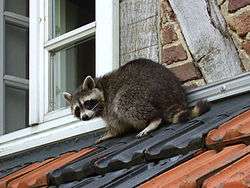Generalist and specialist species
A generalist species is able to thrive in a wide variety of environmental conditions and can make use of a variety of different resources (for example, a heterotroph with a varied diet). A specialist species can thrive only in a narrow range of environmental conditions or has a limited diet. Most organisms do not all fit neatly into either group, however. Some species are highly specialized (the most extreme case being species that can only eat one specific type of food), others less so, and some can tolerate many different environments. In other words, there is a continuum from highly specialized to broadly generalist species.

Omnivores are usually generalists. Herbivores are often specialists, but those that eat a variety of plants may be considered generalists. A well-known example of a specialist animal is the Monophagous koala, which subsists almost entirely on eucalyptus leaves. The raccoon is a generalist because it has a natural range that includes most of North and Central America, and it is omnivorous, eating berries, insects such as butterflies, eggs, and various small animals.
The distinction between generalists and specialists is not limited to animals. For example, some plants require a narrow range of temperatures, soil conditions and precipitation to survive while others can tolerate a broader range of conditions. A cactus could be considered a specialist species. It will die during winters at high latitudes or if it receives too much water.
When body weight is controlled for, specialist feeders such as insectivores and frugivores have larger home ranges than generalists like some folivores (leaf eaters). Because their food source is less abundant, they need a bigger area for foraging.[1] An example comes from the research of Tim Clutton-Brock, who found that the black and white colobus, a folivore generalist, needs a home range of only 15 ha. On the other hand, the more specialized red colobus monkey has a home range of 70 ha, which it requires to find patchy shoots, flowers and fruit.[2]
When environmental conditions change, generalists are able to adapt, but specialists tend to fall victim to extinction much more easily.[3] For example, if a species of fish were to go extinct, any specialist parasites would also face extinction. On the other hand, a species with a highly specialized ecological niche is more effective at competing with other organisms. For example, a fish and its parasites are in an evolutionary arms race, a form of co-evolution, in which the fish constantly develops defenses against the parasite, while the parasite in turn evolves adaptations to cope with the specific defenses of its host. This tends to drive the speciation of more specialized species provided conditions remain relatively stable. This involves niche partitioning as new species are formed, and biodiversity is increased.
| Generalist | Specialist |
|---|---|
| A generalist species is a species that generally has a wide range of things in their diets as well as a relatively large area of habitat. | A specialist species is the opposite of the generalist in the fact that specialists require a very certain type of food or can only eat a very small range of things, and usually has a very specific list of things needed in its habitat. |
| Raccoons are a very good example of a generalist omnivore because they eat a wide variety of things and have a very large area in which they live. | Specialist species are generally not omnivores because they only eat a specific thing or a few specific things. |
| Coyote is a great example of a generalist carnivore because they eat pretty much anything with meat on its bones that they can kill or find somewhere in the woods they also live in a very large area. | The Venus flytrap is a good example of a specialist carnivore because they can't move at all to hunt for food and they can only consume insects and small frogs and lizards that walk on their mouth/trap. |
| The whitetail deer is an example of a herbivore generalist because they have the biggest distribution than any other large mammal in North America they also are able to eat a pretty wide variety of plants and trees. | Pandas are an excellent example of a herbivore specialist because they have a specific niche that they live in and their diet consists only of bamboo. |
| A generalist is decided on the area in which they live and what their diet consists of; generalists usually aren't picky eaters, and can eat a wide variety of things, as well as having a large area in which they inhabit. | Specialists are also decided in the same way and with the same features what they eat and how big of an area they inhabit; specialists usually do not eat a wide variety of things and do not inhabit a big area. |
References
- Krebs, J. R.; Davies, N. B. (1993). An Introduction to Behavioural Ecology. Wiley-Blackwell. ISBN 0-632-03546-3.
- Clutton-Brock, T.H. (1975). "Feeding behaviour of red colobus and black and white colobus in East Africa". Folia Primatologica. 23 (3): 165–207. doi:10.1159/000155671. PMID 805763.
- Townsend, C.; Begon, M.; Harper, J. (2003) Essentials of Ecology (2nd edition) p.54-55 Blackwell, ISBN 1-4051-0328-0
https://www.afbr-bri.org/niches-generalists-and-specialists/
https://www.webpages.uidaho.edu/range556/appl_behave/projects/different_strokes.html